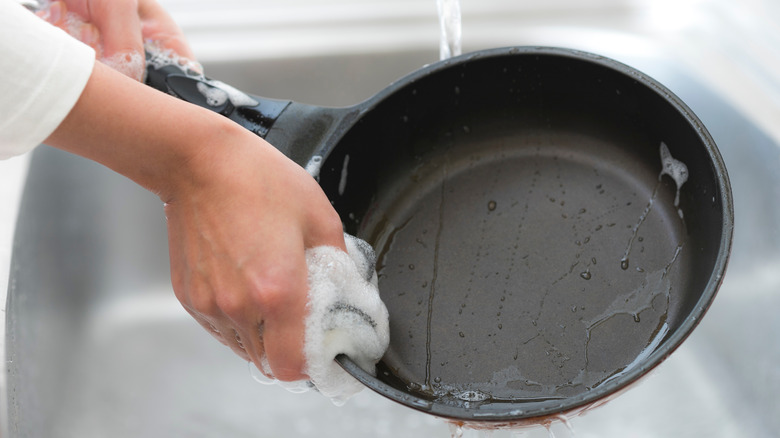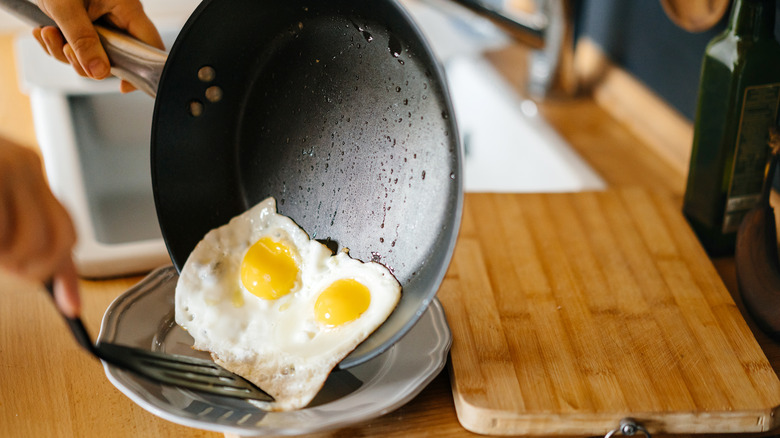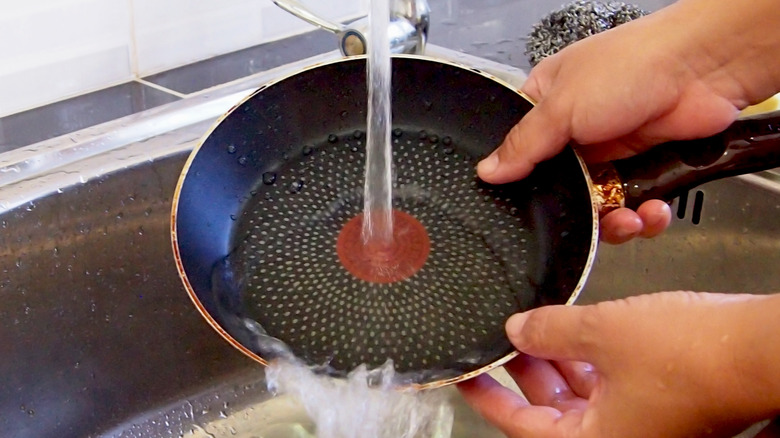The Nonstick Pan Cleaning Tricks You Should Be Using Yourself
Whether you are a seasoned chef or master of the home-cooked meal, you probably have a small collection of go-to pots and pans handy for when you're creating your next culinary masterpiece. This could come in the form of a sturdy set of ceramic cookware or glimmering stainless steel frying pans. Another popular choice around the kitchen is the nonstick pan, which makes cooking eggs and other items a breeze with its conveniently slippery surface. Nonstick pans can help you create amazing meals without the use of extra butter or oils that are typically necessary to prevent sticking when using regular cooking pans.
The friction-free coating that covers these types of pans is actually made using a synthetic chemical called Teflon, according to Healthline. Nonstick pans have been under scrutiny over worries that the elements used in their products might cause illness, however, this was linked to a chemical known as perfluorooctanoic acid or PFOA, which has not been used in the production of nonstick pans since 2013. Another thing some people might not be aware of is that nonstick pans are meant for mid to lower-heat cooking. Teflon can actually start to degrade at temperatures over 500 degrees Fahrenheit, and this could lead to nasty toxins being exposed in the air or the chipping away of your pans which could be accidentally ingested. Now with proper use and care, you can enjoy years of meals made by utilizing these great pieces of nonstick cookware.
When to use your nonstick pan
Each cooking pan you use, whether stainless steel, cast iron, or nonstick, is actually better suited for certain cuisines. For example, if you are thinking of searing a nice cut of steak on your stovetop, making a fluffy cornbread, or are doing some light deep frying then you may want to consider using a cast iron pan, according to author and food writer Ann Taylor Pittman, via Martha Stewart. The thick material can retain high temperatures for a longer period of time and is sturdy enough to handle the heat. For pasta sauces, a good stainless steel pan has a thin profile which is ideal for varying temperatures on the fly. Nonstick pans are the perfect thing to use for more delicate dishes. Eggs, omelets, and thinly sliced meats or fish that have a bread coating are just the types of meals that you don't want sticking to the surface of your frying pans.
Now that you have a dirty pan, you might be wondering how exactly you should clean it. First of all, make sure you allow the pan to cool down before you clean it. The last thing you want to do is place a hot pan in cool water, as this might cause the metal to warp and ruin the useful nonstick coat on the surface. Once your pan has cooled, there are a variety of ways to clean it.
Ways to properly clean your nonstick pan
Now that you are done using your nonstick pan and it's ready to be cleaned, there are a few tricks that you can use to ensure that it lasts for many meals to come. Luckily, because of the Teflon coating, you shouldn't have to worry too much about sticky messes being left on the surface. If you take care of your nonstick pans they should last you up to five years, according to Wirecutter. When washing your pan, you should never use a coarse sponge or steel wool, as these will scratch the slippery coating and cause irreversible damage. Instead, make sure that you use a dishcloth, soft sponge, or dish brush. Your nonstick cookware should always be washed by hand and never placed in your dishwasher. This is because the combination of high temperatures from your dishwasher and the chemicals used to clean the dishes could actually degrade the coating of your pan and drive the material to flake, warns Today.
For a thorough clean that won't damage the pan, add dish soap to warm water in your sink and scrub with a soft sponge. When you are done, dry the pan with a paper towel or a dishtowel. If you want a more natural cleaning option, you could use a scrubbing paste made from one part baking soda and two parts water. This will do the trick, as well as rid your pan of any burnt, hard-to-remove messes, suggests MasterClass.


